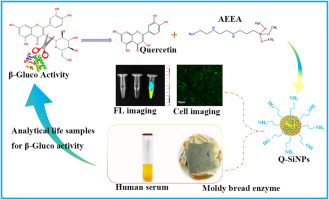Abstract
beta-Glucosidase (beta-Gluco) is an enzyme that is crucial to numerous diseases, including cancer, and in sector of industries, it is used in the manufacturing of food. Measuring its enzymatic activity is critical for biomedical studies and other activities. Herein, we have developed a novel and precise fluorescent sensing method for measuring beta-Gluco activity based on the production of yellow-green fluorescent quercetin-silicon nanoparticles (Q-SiNPs) produced from quercetin (QN) as a reducing agent and 3-[2-(2-aminoethyl amino) ethylamino] propyl-trimethoxy silane (AEEA) as a silane molecule. beta-Gluco hydrolyzed quercetin-3-O-beta-D-glucopyranoside (QO-beta-DG) to produce QN, which was then used to produce Q-SiNPs. Reaction parameters, including temperature, time, buffer, pH, and probe concentration, were carefully tuned in this study. Subsequently, the fluores-cence intensity was performed, showing good linearity (R2 = 0.989), a broad linear dynamic range between 0.5 and 12 U L-1, and a limit of detection (LOD) as low as 0.428 U L-1, which was proven by fluorescence measurements. Most importantly, various parameters were detected and characterized with or without /3-Gluco. The designed probe was successively used to assess /3-Gluco activity in human serum and moldy bread. However, the mathematical findings revealed recoveries for human serum ranging from 99.3 to 101.66% and for moldy bread from 100.11 to 102.5%. Additionally, Q-SiNPs were well suited to being incubated in vitro with L929 and SiHa living cells, and after using an Olympus microscope, imaging showed good fluorescence cell images, and their viability evinced minimal cytotoxicity of 77% for L929 and 88% for SiHa. The developed fluorescence biosensor showed promise for general use in diagnostic tests. Therefore, due to this outstanding sensing modality, we anticipate that this research can provide a novel schematic project for creating simple nanostructures with a suitable plan and a green synthetic option for enzyme activity and cell imaging.

Keywords Plus:ALKALINE-PHOSPHATASE,ENZYME
Published in ANALYTICA CHIMICA ACTA,Volume1280,10.1016/j.aca.2023.341880;NOV 1 2023


